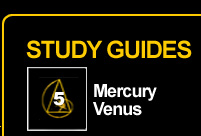






Mercury is the closest planet to the Sun, and the second-smallest planet in the Solar System. Mercury ranges from −0.4 to 5.5 in apparent magnitude, and its greatest angular separation from the Sun (greatest elongation) is only 28.3°, meaning it is only seen in twilight. The planet remains comparatively little-known: the only spacecraft to approach Mercury was Mariner 10 from 1974 to 1975, which mapped only 40–45% of the planet's surface.
Physically, Mercury is similar in appearance to the Moon as it is heavily cratered. It has no natural satellites and no atmosphere. The planet has a large iron core which generates a magnetic field about 1% as strong as that of the Earth. Surface temperatures on Mercury range from about 90-700 K, with the subsolar point being the hottest and the bottoms of craters near the poles being the coldest.
The Romans named the planet after the fleet-footed messenger god Mercury, probably for its fast apparent motion in the twilight sky. The astronomical symbol for Mercury a stylized version of the god's head and winged hat atop his caduceus an ancient astrological symbol. Before the 5th century BC, Greek astronomers believed the planet to be two separate objects. The Chinese, Korean, Japanese, and Vietnamese cultures refer to the planet as the water star, based on the Five Elements..
Mercury has been known since at least the time of the ancient astrologers, Sumerians (3rd millennium BC), who called it Ubu-idim-gud-ud. The earliest recorded detailed observations were made by the Babylonians, who called it gu-ad or gu-utu. It was given two names by the ancient Greeks: Apollo when visible in the morning sky and Hermes when visible in the evening. In astrological calculations, these two cycles were called Morning Star and Evening Star. However, Greek astronomers came to understand that the two names referred to the same body, with Pythagoras being the first to propose the idea. Heraclitus even believed that Mercury and Venus orbited the Sun, not the Earth.
In 1631, Pierre Gassendi, who viewed the transit of Mercury predicted by Johannes Kepler, became the first person to observe the transit of a planet across the Sun. In 1639, Giovanni Zupi used a telescope to discover that the planet had orbital phases similar to Venus and the Moon. The observation demonstrated conclusively that Mercury orbited around the Sun.
Venus
When named thus by the ancient Greeks, it was thought that Phosphorus and Hesperus (Venus in the evening) were two different celestial objects. It was the Greek philosopher and mathematician Pythagoras who first realized that Phosphorus and Hesperus were the same object.
Venus is the second planet from the Sun. A terrestrial planet, it is sometimes called Earth's "sister planet", as the two are very similar in size and bulk composition. The planet Venus is also termed Lucifer when appearing as the morning star.
Venus is named after the Roman goddess of love, Venus.
The adjective Venusian is commonly used for Venus, but the Latin adjective is Venereal, which is avoided because of its modern association with sexually transmitted diseases. Some astronomers use Cytherean, which comes from Cytherea, another name for Aphrodite in ancient Greek Mythology. Other less common adjectives include Venerean, Venerian, and Veneran.
The Chinese, Korean, Japanese and Vietnamese cultures refer to the planet as the metal star, based on the Five Elements.
Orbit
Although all planets' orbits are elliptical, Venus's orbit is the closest to circular, with an eccentricity of less than 1%.
As Venus is closer to the Sun than the Earth, it always appears in roughly the same direction from Earth as the Sun (the greatest elongation is 47.8°), so on Earth it can usually only be seen a few hours before sunrise or a few hours after sunset. However, when at its brightest, Venus may be seen during the daytime, making it the only heavenly body that can be seen both day and night besides the Moon. It is sometimes referred to as the "Morning Star" or the "Evening Star", and when it is visible in dark skies it is by far the brightest star-like object in the sky.
The cycle between one maximum elongation and the next lasts 584 days. After these 584 days Venus is visible in a position 72 degrees away from the previous one. Since 5 * 584 = 2920, which is equivalent to 8 * 365 Venus returns to the same point in the sky every 8 years (minus two leap days). This was known as the Sothis cycle in ancient Egypt, and was familiar to the Maya as well. Another association is with the Moon, because 2920 days equal almost exactly 99 lunations (29.5 * 99 = 2920.5).
At inferior conjunction, Venus can get closer to earth than any other planet--little more than 100 times the Moon's average distance. On December 16th, 1850, Venus reached the lowest distance to earth since 1800, with a value of 0.26413854 AU = 39,514,827 kilometres. This will be the closest approach of Venus to earth until December 16th, 2101 when Venus will reach a distance of 0.26431736 AU = 39,541,578 kilometres to earth.
Rotation
Venus has a slow retrograde rotation, meaning it rotates from east to west, instead of west to east as most of the other major planets do. (Pluto and Uranus also have retrograde rotation, though Uranus's axis, tilted at 97.86 degrees, almost lies in its orbital plane.) It is not known why Venus is different in this manner; although it may be the result of a collision with a very large asteroid at some time in the distant past. If the Sun could be seen from Venus' surface, it would appear to rise in the west and set in the east for a 116.75 day-night cycle (Venus' mean solar day), and a Venusian year would thus last 1.92 Venusian "days".
In addition to this unusual retrograde rotation, the periods of Venus' rotation and of its orbit are synchronized in such a way that it always presents the same face toward Earth when the two planets are at their closest approach (5.001 Venusian solar days between each inferior conjunction). This may simply be a coincidence, but there is some speculation that this may be the result of tidal locking, with tidal forces affecting Venus' rotation whenever the planets get close enough together —although the tides raised by Venus on Earth are vanishingly small.
Venus Transit
A transit of Venus across the Sun takes place when the planet Venus passes directly between the Sun and the Earth, obscuring a small portion of the Sun's disc. During a transit, Venus can be seen from the Earth as a small black disc moving across the face of the Sun. The duration of such transits is usually measured in hours (the transits of 2004 and 2012 last about six hours). A transit is similar to a solar eclipse by the Moon, but, although the diameter of Venus is almost 4 times that of the Moon, Venus appears much smaller because it is much further away from the Earth. Before modern astronomy, observations of transits of Venus helped scientists measure the distance between the Sun and the Earth using the method of parallax.
Transits of Venus are the rarest of all predictable astronomical phenomena and currently occur in a pattern that repeats every 243 years, with pairs of transits eight years apart separated by long gaps of 121.5 years and 105.5 years. Before 2004, the last pair of transits of Venus were in December 1874 and December 1882. The first of a pair of transits of Venus in the beginning of the 21st century took place on June 8, 2004 (see Transit of Venus, 2004) and the next in this pair will be on June 6, 2012 (see Transit of Venus, 2012). After 2012, the next transits of Venus will be in December 2117 and December 2125.
The pattern repeats every 243 years because 243 sidereal orbital periods of the Earth (365.25636 days, which is slightly different from the tropical year) is 88757.3 days, and 395 sidereal orbital periods of Venus (224.701 days) is 88756.9 days. Thus, after this time both Venus and Earth have returned to very nearly the same point in each of their respective orbits. This period of time corresponds to 152 synodic periods of Venus.
The pattern of 105.5, 8, 121.5 and 8 years is not the only pattern that is possible within the 243-year cycle. Prior to 1518, the pattern of transits was 8, 113.5 and 121.5 years, and prior to 546, transits always took place 121.5 years apart. The current pattern will continue until 2846, when it will be replaced by a pattern of 105.5, 129.5 and 8 years. Thus, the 243-year cycle is relatively stable, but the number of transits and their timing within the cycle will vary over time.
The safest way to observe the event in 2012 would be to project the image of the Sun, as seen through a telescope, onto a screen. Nevertheless, the event can also be seen with free eyes using special stained glasses. Grade 14 of Welder’s glasses should be used. Observing the Sun without filters can cause a temporary or permanent loss of visual function, as it can damage and even destroy retinal cells.
Cultural History
In many cultures of the world, the transit of Venus across the Sun has been regarded as a rare and therefore an important event that marks major changes in human history. This is true for the Maya and other ancient American civilizations, for the Indian Vedic traditions and for the Western astrology of Mesopotamian origin. It has been claimed that a transit led to the ancient Greeks celebrating the Ancient Olympics every four years as a form of commemoration.
This article is licensed under the GNU Free Documentation License. It uses material from the Wikipedia article "Mercury", Wikipedia article "Venus" and Wikipedia article "Transit of Venus".




